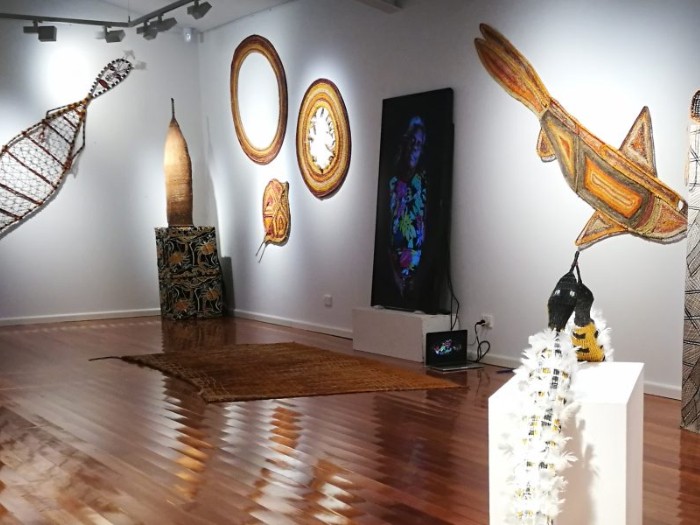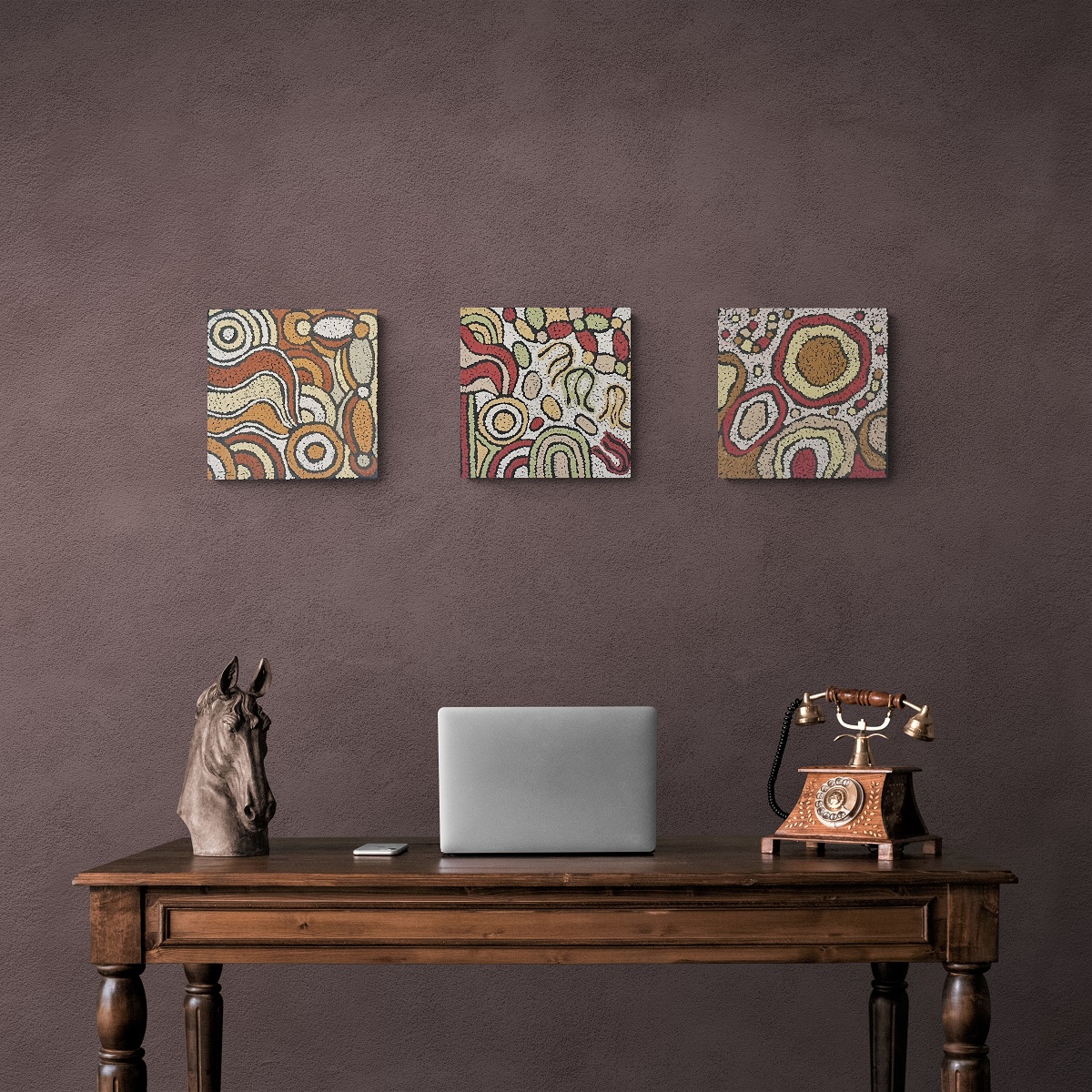
Art Centers
Purchasing artwork from Maliyaa provides a guarantee that your artwork is authentic and ethical. Your purchase will also support the artist’s family and community and provides employment that helps them in preserving a long and proud heritage. Last but not least, you are supporting the future generation of young Aboriginal artists.
Although most of our artists live in small communities, we are also proud to say we represent young Aboriginal Artists throughout Australia including artists in urban setting. Many of them grew up outside remote communities and are independent artists not associated with a community art centre however they are still very much connected to the land and their culture. Most of the young Aboriginal artists that we represent are influenced by more modern art movements as well as traditional Aboriginal styles and are using their own unique and different techniques. However, these artists are still telling their traditional stories and their work is intrinsically tied to their cultural background. This mix of artists is why the Maliyaa collection is so diverse and dynamic.
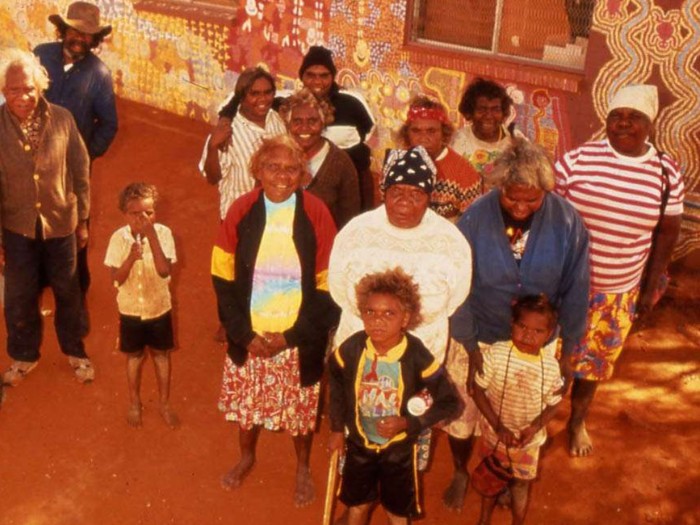
Warlukurlangu Artists
Established in 1985 Warlukurlangu Artists Aboriginal Corporation is a not-for-profit organisation that is 100% Aboriginal-owned by its artists from the remote desert communities of Yuendumu and Nyirripi in Central Australia.
Warlukurlangu Artists is famous for its gloriously colourful acrylic paintings and limited edition prints. The art centre has a national and international profile and its art has been featured in hundreds of exhibitions and publications in Australia and around the world.
Warlukurlangu means ‘belonging to fire’ in the local language, Warlpiri, and is named for a fire dreaming site west of Yuendumu.
Warlukurlangu Artists is based in the community of Yuendumu in Central Australia, located 290km northwest from Alice Springs on the Tanami Road. Yuendumu is a large Aboriginal community; the population fluctuates between 700 to 1000 people and it comprises families from similar language groups with strong cohesive traditional culture. Yuendumu has a school, clinic, police station, several shops and other Aboriginal organisations including Mt Theo Youth Program, Kurdu Kurdukurlangu Childcare Centre, Western Desert Dialysis Unit, PAW Media, and Women’s Centre.
Warlukurlangu Artists also supports the artists from the neighbouring Warlpiri communities of Nyirripi and Yuelumu.
It is a fundamental aim of Warlukurlangu Artists to share Warlpiri culture and in addition, to increase awareness about Aboriginal culture generally, and to broadly support Indigenous causes. Over the years Warlukurlangu Artists has supported its own community and other organisations working to improve conditions for Aboriginal people. It has contributed funds or artworks for fund-raising to a number of projects such as the Yuendumu Community Swimming Pool, Kurdu Kurdukurlangu Childcare Centre and Shalom Gamaroda Scholarship Fund which supports Indigenous students studying for a variety of medical and health related degrees at University of NSW.
Injalak Arts
Injalak Arts is a non-profit Aboriginal-owned social enterprise. The Art Centre in Gunbalanya was officially opened in late November 1989. Prior to 1989 its origins were in a small shed used for screen printing. The building that houses the various functions of the Art Centre is long and flanked on either side by covered verandahs. The artists and weavers work on either side of the building.
Indigenous community art centres play an important role in the artistic and cultural life of traditional Aboriginal artists living in remote communities. Injalak Arts is an outstanding example of a community organisation that is 100% Aboriginal owned and delivers positive social, economic and cultural outcomes for its members.
Injalak Arts has around 200 active members – artists and weavers from Gunbalanya and surrounding outstations. Any Kunwinjku speaking person over the age of 18 is eligible for membership. Although the Arts Centre is located in Gunbalanya, it also services those members who choose to live at their outstations (homelands) thereby generating livelihoods for many individuals and families. The outstations regularly visited are Manmoyi, Mamadawerre and Kabulwarnamyo.
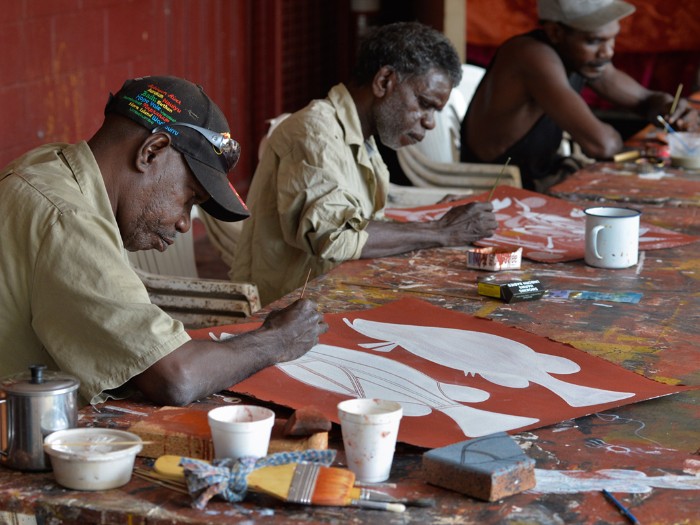
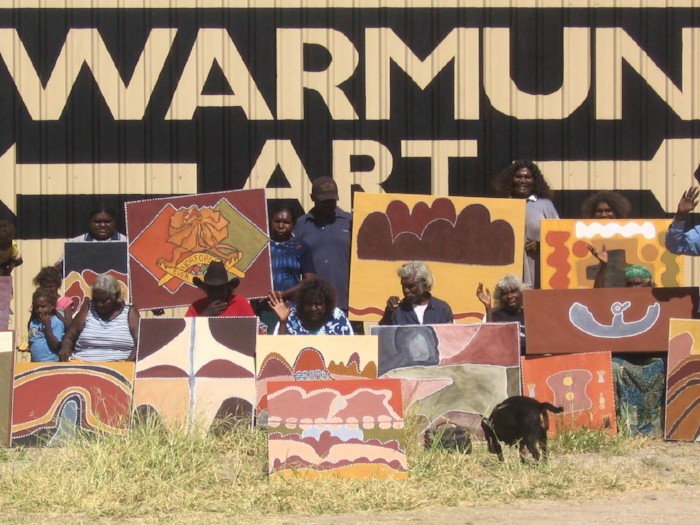
Warmun Art Centre
Warmun Art Centre is owned and governed by Gija people with 100% of income returning to the community. The centre was established by founding members of the contemporary painting movement in Warmun such as Queenie McKenzie, Madigan Thomas, Hector Jandany, Lena Nyadbi, Betty Carrington and Patrick Mung Mung. These elders recognised and responded to the need for a community owned and controlled centre through which they could support, maintain and promote Gija art, language and culture.
Warmun artists are renowned for their use of natural ochre and pigments on canvas, which is integral to the contemporary expression of land and culture as identity for Gija people. The work of Warmun artists’ is an inseparable and celebratory part of Gija culture and country, and draws on traditional Ngarranggarni (Dreaming) stories and contemporary life. Warmun art has a national and international reputation thanks to the leadership of highly successful Warmun artists like Rover Thomas and Queenie McKenzie, George Mung Mung and Paddy Jaminji.
Now internationally renowned painters Lena Nyadbi, Patrick Mung Mung, Mabel Juli, Shirley Purdie, Madigan Thomas, Gordon Barney, Phyllis Thomas, Churchill Cann and Betty Carrington lead the way for a group of more than sixty emerging and younger artists currently painting for the art centre.
This new generation of Warmun artists works with the same, time-honoured materials and stories. The emerging works display a fresh, original and vibrant style that transcends cultural boundaries and places many Warmun artists at the forefront of contemporary art in Australia.
Artists of Ampilatwatja
The Artists of Ampilatwatja community was established in 1999 near Alice Springs in the Northern Territory. The work produced by the artists is recognisably distinct from other Aboriginal artistic communities, due to the application of fine dots and the often bright and figurative depiction of the land.
Most of the artists paint Arreth, which translates to ‘strong bush medicine’, demonstrating a deep connection to country. A veritable source of life, the land has provided and sustained Alyawarr people for generations, as every plant and animal has a vital role to play within the ecological system.
The paintings pay homage to the significance and use of traditional bush medicine, allowing an insight into their community. Yet underneath the iridescent surfaces, there is an underlying sense that there is more to these landscapes than meets the eye. In keeping with the religious laws, the artists reveal only a small amount of knowledge to the uninitiated. The esoteric information that is held sacred to these artists and their people is concealed from the public and layered underneath the common visual narrative, masked by the delicate layered dots of the painting. The many levels of interpretation permit artists to present their art to an often culturally untutored public without compromising its religious nature. Artists talk of two broad levels of interpretation, the “inside” stories which are restricted to those of the appropriate ritual standing, and the “outside” stories which are open to all.
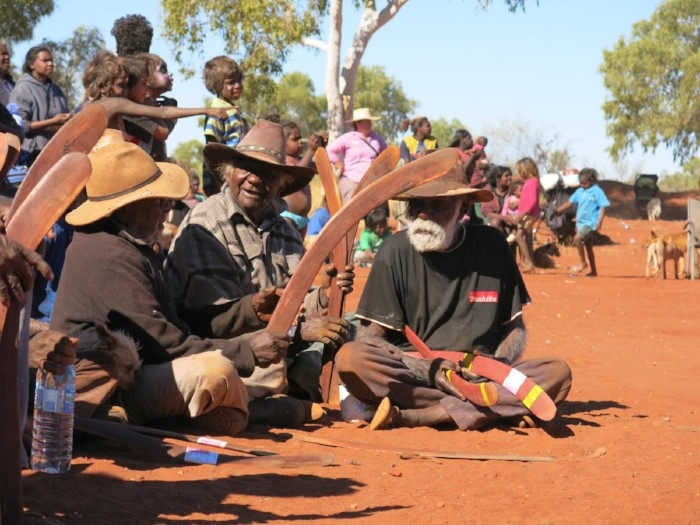
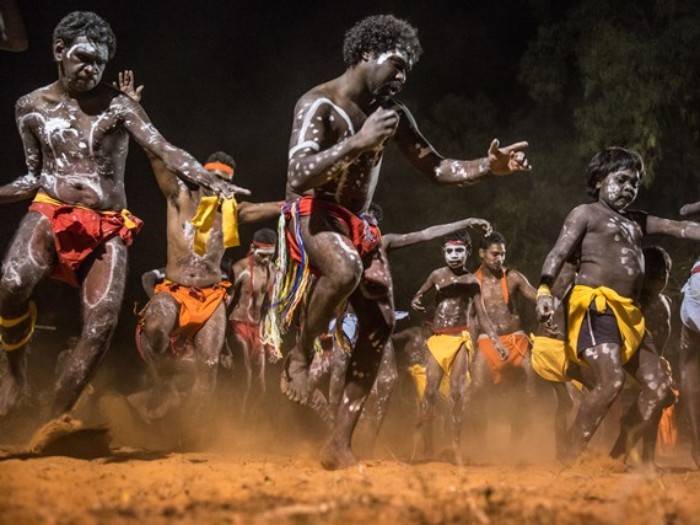
Waringarri Aboriginal Arts
Established in the late 1970’s, in the heart of Miriwoong country at Kununurra in the Kimberley region of northern Australia, Waringarri artists share the importance of their Country and Culture.
Waringarri is the first wholly indigenous owned art centre established in the Kimberley region and one of the oldest continuously operating art centres in Australia supporting economic independence for artists and their community.
The centre operates artists’ studios and galleries and supports more than 100 artists as painters, printmakers, wood carvers, boab engravers, sculptors and textile artists. Cultural tours and performances compliment the visitor experience with a rich insight into Miriwoong culture.
All proceeds from art sales, art commissions and cultural tourism is returned to the community to support our ongoing program of arts and cultural projects.
Refurbished in 2011 the distinctive quality about Waringarri Aboriginal Arts is the sense of an authentically creative and collaborative environment. Artist studios extend into landscaped gardens areas. Verandas are supported with individually painted poles and pathways of sandblasted pavers present a range of artist designs. The Dawang Gallery is a unique cultural information space presenting selected works from the Waringarri collection complimented with multi-media presentations to share the richness of Miriwoong cultural identity with both community and visitors.
There are more than 100 artists supported through the centre which also includes artists from the remote Kira Kiro Art Centre in Kalumburu on the northern Kimberley coast. Artists are supported by a team of local Aboriginal arts-workers.
Maningrida Arts & Culture
Maningrida Arts & Culture is a pre-eminent site of contemporary cultural expression and art-making, abundant with highly collectable art and emerging talent.
Through their homelands resource organisation, Bawinanga Aboriginal Corporation, artists turned an art trade that began just over 50 years ago into a multi-million dollar arts and cultural enterprise. Maningrida Arts & Culture supported hundreds of artists on their homelands, more than 20 artworkers, held 20 exhibitions annually, won prestigious awards, and enjoyed the international fame and success that the boom in the Aboriginal art market of the 1990s and 2000s enabled.
Acclaimed senior artists including John Mawurndjul, brothers Owen Yalandja and Crusoe Kurddal, Bob Burruwal, Lena Yarinkura and Laurie Marbaduk continue to expand their mediums and narratives. Artists such as Paul Nabulumo, Samson Bonson, Anniebelle Marrngamarrnga, Samuel Namundja, Kay Lindjuwanga and Fiona Jin-majinggal have emerged to become a formidable force in the national and international landscape. They sit alongside the leading proponents of a fibre sculpture movement. Frewa Bardaluna, Helen Stewart, Vera Cameron, Lorna Jin-gubarrangunyja, Freda Wayartja Ali, Bonnie Burarn.garra and Doreen Jinggarrabarra are a group of mostly female artists who reinterpret functional forms using natural fibres to create highly sought-after pieces across the fine art and interior design sectors.
We protect the place in history for those artists who have come before, among them: Yirawala, Wally Mardarrk, John Bulunbulun, Peter Marralwanga, England Banggala, Elizabeth Mipilangurr, Lena Djamarrayku, Mary Marabamba and Jack Wunuwun.
Their legacy can be experienced in current and forthcoming exhibitions across Australia and internationally, showcasing the collectable artwork of today’s artists.
